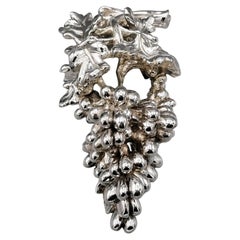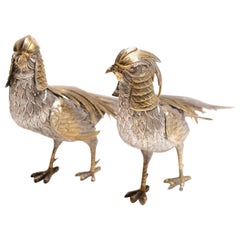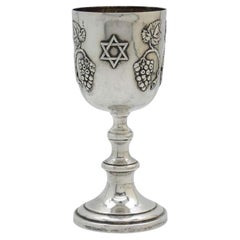Arval Argenti Valenza Natural Specimens
to
1
1
1
1
1
1
1
1
1
1
Height
to
Width
to
1
1
1
77
157
92
23
22
Creator: Arval Argenti Valenza
20th Century Italian Pure 990 Silver Grape Bunch
By Arval Argenti Valenza
Located in VALENZA, IT
Italy, a country that produces great wines and an ancient agricultural tradition, could not fail to dedicate its art also to create prestigious objects concerning this excellence for...
Category
Late 20th Century Italian Other Arval Argenti Valenza Natural Specimens
Materials
Sterling Silver
$1,917 Sale Price / item
20% Off
Related Items
Pair of 20th Century Silver Pheasants
Located in Los Angeles, CA
Pair of 800 silver pheasants. Gold vermeil. European (probably Austria).
Category
Early 20th Century Austrian Arval Argenti Valenza Natural Specimens
Materials
Silver
A 20th Century American Silver Kiddush Goblet
Located in New York, NY
This elegant 20th-century American silver Kiddush goblet is a striking example of refined Judaica design, blending traditional Jewish symbolism with classic American silversmithing o...
Category
20th Century American Arval Argenti Valenza Natural Specimens
Materials
Sterling Silver
20th Century Sterling Silver Hip Flask
By Marples & Beasley
Located in Jesmond, Newcastle Upon Tyne
An exceptional, fine and impressive antique George V English sterling silver hip flask, an addition to our wine and drinks related silverware collection.
This exceptional antique George V sterling silver hip flask has a plain rectangular rounded form.
This impressive flask has a subtly curved form proffering a comfortable fit in the majority of pockets.
The surface of the flask is plain and unembellished.
This impressive antique flask is fitted with a plain domed hallmarked hinged cover with bayonet fitting.
This George V flask retains the original full hallmarked detachable push fit drinking cup which features the original gilt interior, this drinking vessel is a large example for its type.
This flask has been tested and is water tight and ready for use.
To ensure the flask remains water tight, the cork should be moist and therefore fully expanded to provide an effective seal.
There are two recommended methods to ensure the cork does not dry out and shrink:
Method one: Keep fluid in the flask at all times, and keep the flask on its side to ensure the cork remains wet.
Method two: Fill the flask to the brim with fluid and close. Leave it like this overnight, or 24 hours if possible, before use.
Condition
This antique hip flask...
Category
1910s English Art Deco Vintage Arval Argenti Valenza Natural Specimens
Materials
Silver, Sterling Silver
Vintage Silver Centerpiece, Italy, Mid-20th Century
Located in Roma, IT
Flower centrepiece is a precious decorative object realized in the 20th century.
A very elegant silver centrepiece in the shape of a flower
Supported by three small feet under ...
Category
Mid-20th Century Italian Arval Argenti Valenza Natural Specimens
Materials
Sterling Silver
20th Century Victorian Style Handcrafted Sterling Silver Epergne, Italy, 1998
By Argenteria Auge
Located in Cagliari, IT
A remarkable Victorian style handcrafted chiseled sterling silver epergne by Italian silversmith Argenteria Auge from Milan. The entire epergne is beautifully embellished with flower...
Category
1990s Italian Victorian Arval Argenti Valenza Natural Specimens
Materials
Sterling Silver
$12,041
H 10.24 in W 20.08 in D 15.75 in
Attributed to Buccellati, 20th Century Sterling Silver Capercaillie
By Buccellati
Located in North Miami, FL
Presenting a remarkable 20th-century silver capercaillie sculpture, exquisitely attributed to the distinguished Buccellati workshop. This piece captures the essence of the capercaill...
Category
20th Century Italian Arval Argenti Valenza Natural Specimens
Materials
Stone, Sterling Silver
20th Century Pirced Handicraft Sterling Silver Serving Tray, Italy, 1998
By Ditta Messulam Enrico
Located in Cagliari, IT
Gorgeous sterling silver two handled serving tray. Splendid work of the great Italian silversmiths.
The wonderful hand-made work makes the edges of this object look like a lace.
M...
Category
1990s Italian Baroque Revival Arval Argenti Valenza Natural Specimens
Materials
Sterling Silver
$18,062
H 2.37 in W 23.04 in D 16.93 in
20th Century, Royal Wedding Solid Silver Wager Cup, London, c.1973
Located in Royal Tunbridge Wells, Kent
Novelty 20th century solid silver wager / marriage cup, the cups design inspired by the early 16th century German example, modelled as a female figure sup...
Category
20th Century British Arval Argenti Valenza Natural Specimens
Materials
Silver
$1,371
H 8.27 in W 4.73 in D 2.76 in
Silver Oval Centerpiece, Italy, Mid-20th Century
Located in Roma, IT
Oval centrepiece is a precious decorative object realized by Italian Manufacture in the mid-20th century.
A very elegant silver oval centrepiece with wavy decorated edges.
Very...
Category
Mid-20th Century Italian Arval Argenti Valenza Natural Specimens
Materials
Sterling Silver
19th Century Italian Sterling Silver Madonna, circa 1830
Located in Milano, IT
Embossed and engraved silver plaque
La Madonna del lago (The Madonna of the Lake)
Probably Milan, post 1824
Brass frame
It measures 16.14 in x 13.85 in (41 x 35.2 cm) and it weighs 10.357 pounds (4.698 g): silver 1.31 pounds (598 g) + brass 9.03 pounds (4.100 g)
State of conservation: some abrasions on the bottom. The frame is old, but not original.
The plaque is made up of a sheet of embossed and engraved silver, and held in a solid brass frame. It depicts the “Madonna del lago” – “Madonna of the Lake” - (the Madonna with Child and San Giovannino) by Marco d'Oggiono (Oggiono, 1474 circa - Milan, 1524 circa), while changing only the background landscape. Almost certainly the subject reproduced in the plaque was taken from a famous engraving by Giuseppe Longhi (Monza, 1766 - Milan, 1831), one of the greatest engravers of his era.
The silver is unmarked, probably because originally the Madonna was due to be exposed in a church: sometimes precious metals destined for worship and liturgical use would be exempted from payment and were, therefore, not marked.
It is very likely that the plaque was made in Milan because in this city in 1824 the engraving by Giuseppe Longhi was made and printed. In addition, in Milan, the alleged lost painting by Leonardo da Vinci in his Milanese period (1482-1500) would be produced; this is the painting from which Marco d'Oggiono took his version.
The painting
Marco d?Oggiono was one of Leonardo da Vinci's most brilliant students and collaborators (D. Sedini, Marco d’Oggiono, tradizione e rinnovamento in Lombardia tra Quattrocento e Cinquecento, Roma 1989, pp. 151-153, n. 56; p. 225, n. 124, with previous bibliography). His style reflects in every way that of the Tuscan Maestro, so much so that he was the one who executed some copies of da Vinci's paintings. The execution of the “Madonna del Lago” probably draws inspiration from a lost painting by the Maestro, created while he was living in Milan (1482-1500). There are many similarities with other works by Leonardo such as the “Vergine delle rocce” or the “Vergine con il Bambino e San Giovannino, Sant’Anna e l’Agnello”.
The painting, from which the drawing and then the famous engraving were taken, is found today at the M&G Museum of Bob Jones University in Greenville, South Carolina, where it came to rest after the sale of the Harrington Collection in London in 1917.
The work appears in the inventories of the collection of Napoleon and Joséphine Bonaparte at the castle of Malmaison, before 1809.
The Malmaison building was born and developed in the 17th and 18th centuries. In the 18th century it belonged to Jacques-Jean Le Coulteux du Molay, a wealthy banker. Later, during the Directory, Joséphine Bonaparte de Beauharnais bought it on April 21st, 1799, but settled at the castle definitively only after her husband separated from her in 1809. She remained there until 1814, the year of her death. When Joséphine died, the estate passed to her son Eugène de Beauharnais, who moved to Munich with his whole family in 1815, bringing with him the collection of paintings he inherited from his mother. Eugène died in 1824 and his wife Augusta of Bavaria (von Bayern), unable to keep it, in 1828 sold the Malmaison to the Swedish banker Jonas-Philip Hagerman.
It is likely that in this period Augusta also sold part of the paintings inherited from her husband, including the “Madonna del Lago”. This painting then came into the possession of Leicester Stanhope, fifth Earl of Harrington (1784 - 1862) and then was passed down to his descendants.
In 1917, at the death of Charles, eighth Earl of Harrington, his brother Dudley inherited the title and properties and he put up a part of his collections for sale. Among these, precisely, the painting by Marco d'Oggiono was to be found.
On the occasion of that auction the painting was presented as a work by Cesare da Sesto, by virtue of a handwritten note by the Countess of Harrington on the back of the table. However, already in 1857, the German critic Gustav Waagen had identified Marco d'Oggiono as the author of the painting, then exhibited in the dining room of Harrington House in London (Treasures of Art in Great Britain, in 4 volumes, London, 1854 and 1857).
The engraving
Giuseppe Longhi was one of the most renowned engravers in Italy between the end of the 18th century and the first quarter of the 19th century.
In 1824 Giuseppe Longhi, based on a design by Paolo Caronni, made a famous engraving of the painting of Marco d?Oggiono. The activity of Longhi was then at the peak of his notoriety, enough to earn him very substantial commissions; it is not risky to suppose that some of his successful engravings were also reproduced using other means: in our case in silver. (A. Crespi, a cura di, Giuseppe Longhi 1766–1831 e Raffaello Morghen...
Category
1820s Italian Neoclassical Antique Arval Argenti Valenza Natural Specimens
Materials
Sterling Silver, Brass
20th Century Sterling Silver Photograph Frame
By Sanders & Mackenzie
Located in Jesmond, Newcastle Upon Tyne
An exceptional, fine and impressive, large antique George V English sterling silver photograph frame; an addition to our ornamental silverware collection.
This exceptional antique George V sterling silver photograph frame has a plain rectangular form.
The surface of this antique photo frame...
Category
1920s English Vintage Arval Argenti Valenza Natural Specimens
Materials
Silver, Sterling Silver
A Silver Modern Dreidel, 20th Century
Located in New York, NY
A Silver Modern Dreidel made in the 20th Century.
This Silver modern Dreidel is uncommonly made. The sides of the dreidel are square and it has the Hebrew letters Nun, Gimmel, Hey, and Shin prominently displayed but that's where the commonality stops. The top handle is long and cylindrical and the bottom point where the dreidel spins is very similar. We have seen this design on some bone dreidels.
The top is slightly tilted upwards and has designs that resemble spherical beads encircled by filigree which are common on some Israeli Kiddush goblets.
Even the letters which are the smae as most dreidels yet have unique designs. The Gimmel is crowned with an eight-branch Menorah, the Nun is placed within an oil pourer...
Category
20th Century Arval Argenti Valenza Natural Specimens
Materials
Silver
Arval Argenti Valenza natural specimens for sale on 1stDibs.
Arval Argenti Valenza natural specimens are available for sale on 1stDibs. These distinctive items are frequently made of sterling silver and are designed with extraordinary care. There are many options to choose from in our collection of Arval Argenti Valenza natural specimens, although silver editions of this piece are particularly popular. Prices for Arval Argenti Valenza natural specimens can differ depending upon size, time period and other attributes — on 1stDibs, these items begin at $2,221 and can go as high as $2,221, while a piece like these, on average, fetch $2,221.
Recently Viewed
View AllMore Arval Argenti Valenza Furniture
Arval Argenti Valenza Animal Sculptures
Arval Argenti Valenza Figurative Sculptures
Arval Argenti Valenza Sterling Silver
Arval Argenti Valenza Vases and Vessels
Arval Argenti Valenza Boxes
Arval Argenti Valenza Collectibles and Curiosities
Arval Argenti Valenza Centerpieces
Arval Argenti Valenza Candle Holders
Arval Argenti Valenza Desk Accessories
Arval Argenti Valenza Tea Sets
Arval Argenti Valenza Bowls and Baskets
Arval Argenti Valenza Platters and Serveware


